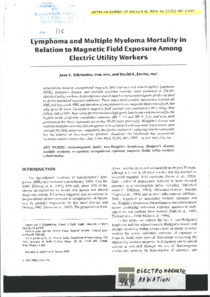Lymphoma and multiple myeloma mortality in relation to magnetic field exposure among utility workers

Schroeder, Jane C. ; Savitz, David A.
American Journal of Industrial Medicine
1997
32
4
392-402
electric power distribution ; electricity industry ; electromagnetic fields ; electromagnetic radiation ; exposure assessment ; frequency rates ; lymphoma ; mortality ; myeloma
Occupational risks
English
The risk of nonHodgkin's lymphoma and two related cancers, Hodgkin's disease and multiple myeloma, was assessed in a large cohort of 138,905 electrical utility workers whose exposure to magnetic fields was estimated. The study involved workers at five electric utility companies. The vital status of all retired or terminated workers was examined. Of 76,934 retired or terminated workers, 20,733 were deceased and 778 were lost to follow up. Over 90% of the cohort were white males; most of them were employed in blue collar jobs. A weak association was found between occupational magnetic field exposure and nonHodgkin's lymphoma (NHL), particularly within intermediate and/or high grade subtypes. Three exposure indexes were used in relation to magnetic fields: duration of employment in an aggregation of 18 occupational categories with greater than background exposure, duration of employment specifically as a linesman, as an electrician or as a powerplant operator (the three most common exposed jobs with mean magnetic field measurements of 0.65, 1.11 and 0.79 tesla respectively), and an estimate of the cumulative magnetic field exposure. The probability of a causal relationship between magnetic field exposure and NHL mortality is low, given the decline in risk for person years at the highest levels of exposure. The risk of NHL was more pronounced in newly hired workers, and there was less of a drop in risk at the highest exposure level. However, there was only a small number of deaths in the subcohort. The authors conclude that it seems unlikely that etiologic heterogeneity within outcome groups would obscure a consistent dose response, but they suggest the possibility of subtype specific associations.
Digital
The ETUI is co-funded by the European Union. Views and opinions expressed are however those of the author(s) only and do not necessarily reflect those of the European Union or the ETUI.